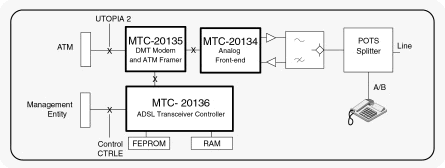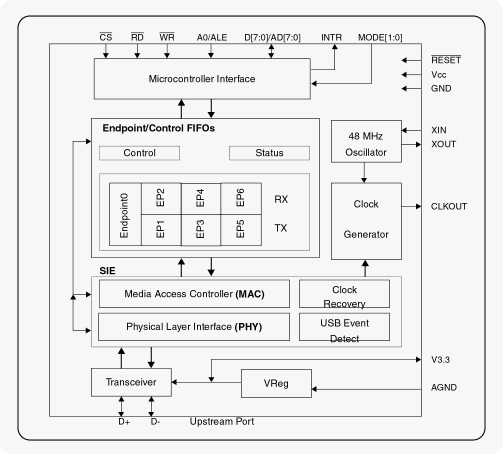
 |
|
Implementing an ADSL to USB Interface Using Spartan Devices |
|
| March 26, 1999 (Version 1.0) |
Application Note: XAPP171
|
![]() To download
a .pdf copy of this Application Note, click
here.
To download
a .pdf copy of this Application Note, click
here.
SummaryThis application note illustrates the use of Spartan devices in an ADSL modem. The Spartan device is used to implement the complex system level glue logic required for the modemís USB interface and manages DMA transfers of ATM cells. The design example shows how cost effective a Spartan device can be in these applications. While the design is targeted at solving a specific problem, it illustrates solutions to a number of general technical issues. These include implementing Utopia interfaces for ATM devices and remote configuration of Spartan devices.Xilinx FamiliesSpartanXL |
IntroductionThis application note illustrates the use of Spartan devices in an Asymmetric Digital Subscriber Line (ADSL) modem. In this application the Spartan device is used to implement the complex system level glue logic required for the modemís Universal Serial Bus (USB) interface. The Spartan device sits between the CPU, USB interface controller, and the ADSL modem, and manages DMA transfers of ATM cells. The design example shows how cost effective a Spartan device can be in these applications.ADSL technology can expand the useable bandwidth of existing copper telephone
lines, delivering high speed data communications at rates of up to 8 Mbps.
The recent G.Lite standard allows for a lower-speed, lower-cost implementation.
The USB interface is becoming the standard on both PC and Macintosh-based
platforms. This document assumes that the reader is familiar with ADSL While the design is targeted at solving a specific problem, interfacing an ADSL chipset to USB, it illustrates solutions to a number of general technical issues. These include implementing Utopia interfaces for ATM devices and remote configuration of Spartan devices. OverviewThe design objectives for this application were threefold. First was the creation of a solution with the lowest possible cost. In this case the target was a semiconductor bill of materials for the USB interface that is significantly less than $10 in volume.The second objective was to deliver a solution that would deliver the best possible performance. Current solutions are able to deliver 2 to 3 Mbps of bandwidth across USB at a much higher price point. The minimum target for this design was to be able to support the full 1.5 Mbps data rate of G.Lite and at the same time get as close to the full G.992.2, 6.1 Mbps data rate. The third objective was to configure the Spartan device from the host via the USB interface. This has the dual benefit of eliminating the requirement for FPGA configuration memory in the modem and the ability to update the configuration in the field. Figure 1 ADSL Modem System Block Diagram
Before we examine the functions implemented in the Spartan device, letís get a overview of the devices that were chosen for the ADSL PHY, USB controller, and CPU blocks. Alcatel Dynamite ChipsetThe ADSL chipset chosen for this design is the Alcatel Dynamite chipset. This three chip set consists of the MT-20134 Analog Front End, the MT-20135 ADSL Modem and ATM Framer, and the MT-20136 ADSL Transceiver Controller. Of these devices the Spartan device interfaces to the MT-20135, and MT-20136.Figure 2 Alcatel Dynamite Chipset Block Diagram
Figure Courtesy Alcatel Microelectronics The MT-20135 sends and receives data in the form of ATM over a standard Utopia level 2 interface. This interface was defined to transfer ATM cells between physical layer devices like the MT-20135 and segmentation and re-assembly (SAR) controllers or ATM switching fabrics. The function of the Spartan device in this design is to handle the handshaking required to convert the full duplex ATM cell stream from the Utopia interface into half-duplex transfers to and from the USB controller. Since both the MT-20135 and the USB controller have internal FIFOs capable of storing a complete ATM cell, the transfers consist of moving data one cell at a time between these FIFOs. The MT-20135 supports non-ATM transport schemes by way of another interface referred to as the Synchronous Link Access Protocol (SLAP) interface. The SLAP interface is not used in this application. The MT-20136 contains an ARM processor, a memory controller, and an interface bus that is connected directly to the MT-20135. The MT-20136 is essentially a single chip processor dedicated to managing the ADSL modem. The Spartan device interfaces to this device via a specialized management interface that Alcatel refers to as CTRLE. This interface is used to control the modem and to query status. National Semiconductor USBN9602The USB interface in the design is based on a National Semiconductor USBN9602 controller. This device, packaged in a 28 pin SOIC package, contains all of the logic necessary to transfer data frames to and from the host with minimal processor intervention. It contains several endpoint FIFOs, two of which are 64 bytes deep. These FIFOs are large enough to contain a complete 53-byte ATM cell plus a control header if required.Figure 3 National USBN9602 Block Diagram
Figure Courtesy National Semiconductor The USB interface could be implemented in a Xilinx FPGA, but for this application the dedicated USB chip provides the most cost-effective solution. In this design the Spartan device contains logic to support two primary functions. The first of these is DMA logic that manages the transfer of ATM cells between the USBN9602 and the Utopia interface. The second function is arbitrating access to the USBN9602 by an 8051 microcontroller. Although the bus on the USBN9602 is designed for direct attachment to the 8051, doing so would eliminate the ability of the Spartan device to directly transfer cells to and from the USBN9602. This is because there is no mechanism available to force the 8051 to relinquish control of the bus when the DMA logic in the Spartan device needs to perform a transfer. Microcontrollers with this feature are significantly more expensive than the 8051. Microcontroller SelectionThe microcontroller chosen for this design was an 80C51. This device is available from multiple vendors and is very inexpensive. Aside from low cost, the features that were required for this application were as follows:
The performance that is required of the microcontroller is minimal. This is due to the fact that the Spartan device handles the real-time transfer of ATM cells between the ADSL chipset and the USB interface. The functions handled by the microcontroller include initializing the Spartan device at startup and responding to status queries from the host received via USB messages. Spartan Device SelectionSpartan devices are available in a range of densities and packages. The following criteria were used to select the device used in this application: |
| I/O Pins | The design requires a total of 60 pins | |
| Voltage | The design operates at 3.3V | |
| Density | The estimated size of the design is 8K gates, broken down as follows: 4K for the USB controller interface, 1K each for the Utopia Tx and Rx state machines, 1K for the microcontroller interface and 1K for the remaining logic. | |
| Performance | The highest clock speed used in the device is 48 MHz, used to clock the USB interface bus state machine. The remaining logic runs at 3 MHz, the Utopia data rate, or 16 MHz or less for the microcontroller. | |
| Packaging | The size constraints imposed on most modem designs dictates a high density surface mount package |
| Supplier | Part Number | Description | Qty |
Unit Cost
|
| Alcatel | MTK-20131 | Dynamite DSL Modem Chipset | 1 |
$60-70
|
| National | USBN9602 | USB Full Speed Function Controller | 1 |
$1-2
|
| Xilinx | XCS10XL-4VQ100C | Spartan FPGA | 1 |
$3-4
|
| Philips | SC80C51BCCB44 | 8 Bit Microcontroller | 1 |
$2-3
|
|
Total
|
$66-79
|
|||
| In terms of performance, the design is capable of transferring cells at twice
the line rate. While this is just one factor in the overall system performance,
we believe that the current limitation in the USB host controllers will
be the limitation for system level performance.
The third objective of in system configuration was met by supporting the transfer of configuration data across the USB interface. This capability should prove valuable in this and other applications where standard practice if not the standard itself is in a state of flux. References
|